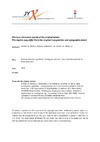Identificador persistente para citar o vincular este elemento:
https://accedacris.ulpgc.es/jspui/handle/10553/41402
| Título: | Nash evolutionary algorithms: testing problem size in reconstruction problems in frame structures | Autores/as: | Greiner, D. Periaux, Jacques Emperador Alzola, José María Galván, B. Winter, G. |
Clasificación UNESCO: | 1206 Análisis numérico 120601 Construcción de algoritmos 120699 Otras (especificar) |
Palabras clave: | Evolutionary algorithms Frame optimization Game strategies Nash equilibrium Structural design, et al. |
Fecha de publicación: | 2016 | Editor/a: | National Technical University of Athens | Conferencia: | 7th European Congress on Computational Methods in Applied Sciences and Engineering, ECCOMAS Congress 2016 | Resumen: | The use of evolutionary algorithms has been enhanced in recent years for solving real engineering problems, where the requirements of intense computational calculations are needed, especially when computational engineering simulations are involved (use of finite element method, boundary element method, etc). The coupling of game-theory concepts in evolutionary algorithms has been a recent line of research which could enhance the efficiency of the optimum design procedure and the quality of the design solutions achieved. They have been applied in several fields of engineering and sciences, mainly, in aeronautical and structural engineering (e.g: in computational fluid dynamics and solid mechanics problems). Among them, Nash-evolutionary algorithms (Nash-EAs) have been recently applied in the single-objective reconstruction inverse design problem in structural engineering (aiming to obtain the structure whose maximum stresses match those stresses considered as references), with successful speed-up of the structural optimum search. Several test cases of different search space size bar structures are handled here, with bar sized structures up to 105 bar elements. Particularly, frames-bar structures with rigid nodes where bending moment and shear effort should also be taken into consideration- are handled here. Influence of the structural size in the comparative performance of Nash-EAs will be investigated and tested. The performance of Nash-EAs improves significantly the one of the standard panmictic evolutionary algorithms. According to the results shown here, this advantage is greater when the problem size increases. | URI: | https://accedacris.ulpgc.es/handle/10553/41402 | ISBN: | 978-618-82844-0-1 | DOI: | 10.7712/100016.2050.6785 | Fuente: | 7th European Congress on Computational Methods in Applied Sciences and Engineering, (ECCOMAS 2016), v. 2, p. 3493-3504, 8 de junio 2016, Chair: 6785. Jorge Magalhaes-Mendes, David Greiner |
| Colección: | Actas de congresos |
Visitas
247
actualizado el 27-sep-2025
Descargas
158
actualizado el 27-sep-2025
Google ScholarTM
Verifica
Altmetric
Comparte
Exporta metadatos
Los elementos en ULPGC accedaCRIS están protegidos por derechos de autor con todos los derechos reservados, a menos que se indique lo contrario.
